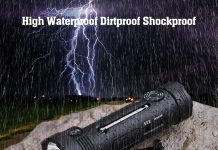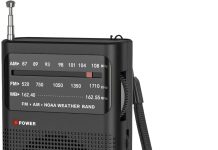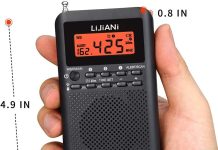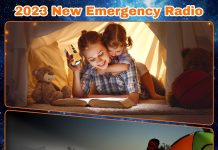Have you ever wondered how often weather radios are used in our daily lives? These compact devices play a crucial role in keeping us informed and safe during severe weather events. From providing accurate forecasts and emergency alerts to helping us stay updated on changing weather conditions, weather radios have become a valuable tool for households across the country. In this article, we will explore the frequency of weather radio usage in everyday life, shedding light on their significance and the impact they have on our safety and preparedness.
Review contents
Importance of Weather Radios
Weather radios are an essential tool for staying safe and informed in the face of severe weather conditions. Whether you’re at home, in the office, or participating in outdoor activities, having a weather radio can provide you with crucial information and help protect you and your loved ones. Let’s explore the importance of weather radios in more detail.
Protection from severe weather
Severe weather events, such as hurricanes, tornadoes, and flash floods, can pose significant risks to life and property. With a weather radio, you can receive real-time updates on approaching storms, allowing you to take necessary precautions and seek shelter before disaster strikes. The ability to receive alerts and warnings directly from the National Oceanic and Atmospheric Administration (NOAA) ensures that you are aware of any immediate threats in your area, enabling you to stay safe and make informed decisions.
Emergency preparedness
Being prepared for emergencies is crucial, and weather radios play a vital role in emergency preparedness. In case of power outages or disruptions to other communication channels, weather radios remain functional, thanks to their battery backup. This ensures that you can still receive critical weather updates, emergency alerts, and instructions from local authorities even when other forms of communication are unavailable. Whether it’s a natural disaster or any other emergency, having a weather radio ensures you have a reliable source of information to guide your actions and keep yourself and your loved ones safe.
Outdoor activities and events
If you enjoy outdoor activities like hiking, camping, or attending outdoor events, a weather radio is a valuable companion. Weather conditions can change rapidly, and being caught off guard can lead to dangerous situations. With a weather radio, you can stay informed about approaching storms, lightning, or other hazardous weather conditions specific to your location. This knowledge allows you to make well-informed decisions about whether to proceed with your plans or seek shelter, ensuring the safety and enjoyment of your outdoor experience.
Usage Scenarios
Weather radios have various application scenarios, catering to different environments and situations. Let’s take a look at some common scenarios where weather radios are essential.
Home usage
One of the primary places where weather radios are used is in households. By having a weather radio at home, you can stay informed about any impending severe weather events that could affect your area, giving you time to prepare or evacuate if necessary. Weather radios are especially important for families with young children, providing an additional layer of protection and peace of mind during inclement weather.
Office and workplace
In a professional setting, weather radios are valuable tools for ensuring the safety and well-being of employees. Whether it’s an office building, construction site, or any other workplace, having a weather radio allows for timely dissemination of weather updates and emergency alerts. This ensures that employees can take appropriate actions to protect themselves and their colleagues, preventing potential injuries or accidents caused by severe weather conditions.
Schools and educational institutions
Educational institutions have a duty to protect their students and staff. Weather radios are often utilized in schools and colleges to monitor weather conditions and receive alerts in case of severe weather. By having a weather radio in place, schools can implement necessary safety protocols such as sheltering in place or evacuating when the situation demands it. This proactive approach significantly reduces the risk of harm to students and staff during severe weather events.
Outdoor activities and events
Whether it’s a music festival, sports event, or a weekend camping trip, outdoor activities and events can be affected by adverse weather conditions. Having a weather radio in such scenarios ensures that event organizers and participants can stay informed about any weather-related changes or threats. This allows for prompt decision-making and appropriate adjustments to ensure the safety and smooth running of the event, mitigating any potential risks to attendees.
Emergency response and government agencies
Weather radios play a crucial role in emergency response and government agencies. These organizations heavily rely on weather radios to monitor severe weather conditions, coordinate rescue operations, and communicate vital information to the public. Weather radios provide a direct line of communication with local communities, allowing for timely and accurate dissemination of emergency alerts, evacuation notices, and other critical information. By utilizing weather radios, emergency response teams can efficiently manage crisis situations and protect the lives and property of those affected.
Frequency of Use
The frequency of weather radio usage depends on various factors, such as the user’s location, weather conditions, and personal requirements. Let’s explore different usage scenarios and understand how often weather radios are used.
Daily usage
While severe weather events may not occur regularly, using a weather radio on a daily basis can still be beneficial. Weather radios provide regular updates on local weather conditions, including temperature, humidity, and forecasts. This information can be particularly useful when planning outdoor activities, determining appropriate clothing for the day, or making decisions about travel routes. Additionally, daily usage of weather radios ensures that individuals are well-acquainted with their functionality and can easily access critical information during severe weather events.
Usage during severe weather events
The frequency of weather radio usage significantly increases during severe weather events. When storms, hurricanes, or tornadoes are approaching, individuals in affected areas rely heavily on their weather radios to receive real-time updates, alerts, and warnings from NOAA. During these times, weather radios serve as a lifeline, providing essential information to make immediate decisions regarding safety measures, evacuation plans, or seeking shelter. The heightened usage during severe weather events showcases the importance and effectiveness of weather radios in critical situations.
Seasonal usage
Certain regions experience specific weather patterns during different seasons. For example, areas prone to hurricanes may heavily rely on weather radios during the hurricane season. Similarly, areas with frequent tornado activity may have increased usage during spring and early summer. The seasonal usage of weather radios depends on the specific climatic conditions and risks associated with each region. By being aware of the weather patterns and risks, users can adapt their usage accordingly and ensure they are prepared when severe weather threatens.
Frequency in different regions
The frequency of weather radio usage varies from region to region, depending on weather patterns, geographical location, and local community awareness. Areas that are prone to severe weather events, such as tornado alley in the United States, typically have higher weather radio usage compared to regions with less volatile weather conditions. Additionally, regions with proactive public safety initiatives and campaigns focused on weather preparedness tend to have a higher frequency of weather radio usage. These areas prioritize education and awareness, ensuring that individuals are equipped with the knowledge and tools necessary to protect themselves during severe weather events.
Benefits and Limitations
Like any other technology, weather radios come with their own set of advantages and limitations. Understanding these factors can help individuals make informed decisions about whether a weather radio is the right choice for their specific needs. Let’s explore the benefits and drawbacks of weather radios.
Advantages of weather radios
-
Reliability: Weather radios provide uninterrupted communication, even during power outages or disruptions to other communication channels. This allows for continuous updates and alerts, ensuring individuals can stay informed and make timely decisions during severe weather events.
-
Real-time information: One of the biggest advantages of weather radios is their ability to deliver real-time weather updates and emergency alerts directly from NOAA. This information is critical for individuals to take appropriate actions and ensure their safety and well-being.
-
Specific area targeting: Weather radios equipped with Specific Area Message Encoding (SAME) technology can be programmed to receive alerts for specific geographic areas. This targeting feature ensures that individuals only receive alerts relevant to their location, reducing unnecessary anxiety and increasing the efficiency of communication.
-
Battery backup and portability: Weather radios often come with built-in battery backup, allowing them to remain functional even during power outages. The portability of weather radios makes them suitable for use in various settings, including homes, offices, outdoor activities, and emergency response situations.
-
Public alert certification: Weather radios that are Public Alert certified meet certain standards and protocols established by NOAA. This certification ensures that the radios are reliable and adhere to specific guidelines for delivering emergency alerts and severe weather warnings.
Drawbacks and limitations
-
Limited coverage range: Weather radios typically have a limited range and may not receive signals in remote or sparsely populated areas. It is essential to consider the coverage range of a weather radio before purchasing to ensure it will function effectively in your specific location.
-
Lack of visual information: Weather radios rely on audio transmission, which may be a limitation for individuals with hearing impairments. Unlike other weather information sources like television or internet, weather radios do not provide visual displays or graphics that can enhance understanding of weather conditions.
-
Necessity for manual activation: While weather radios are designed to automatically receive alerts, they often require manual activation and programming to receive specific area alerts. Failing to correctly program the radio may result in missing important alerts or receiving irrelevant information.
Reminders and notifications
Weather radios often come equipped with features such as alarm clocks, voice or light alerts, and programmable reminders. These features can be useful in reminding individuals to regularly check the weather updates or carry out specific actions related to weather conditions. For example, programming a weather radio to remind you to bring in outdoor furniture during high winds can help prevent damage and maintain safety.
Factors Influencing Usage
Several factors influence the usage of weather radios, ranging from awareness and education to technological advancements. Understanding these factors allows us to assess the extent to which weather radios are utilized in everyday life.
Awareness and education
The level of awareness and education about the importance of weather radios significantly impacts their usage. Communities and individuals who are well-informed about the threats posed by severe weather are more likely to invest in weather radios and utilize them effectively. Public safety campaigns, educational programs, and local initiatives play a significant role in raising awareness about the benefits of weather radios and promoting their usage.
Weather conditions and patterns
The frequency and severity of weather events in a particular region heavily influence the adoption and usage of weather radios. Areas prone to hurricanes, tornadoes, or other severe weather conditions often have higher usage due to the immediate risks associated with such events. Conversely, regions with more stable weather patterns may have lower usage. Understanding the local weather conditions and risks is essential in determining the need and usage of weather radios.
Technological advancements
Advancements in technology have greatly impacted the usage of weather radios. Modern weather radios now come with enhanced features such as SAME technology, battery backup, and improved reception capabilities. These technological advancements make weather radios more reliable, functional, and user-friendly, increasing their overall appeal and usage.
Access and affordability
The accessibility and affordability of weather radios also influence their usage. Availability of weather radios in local stores and online platforms ensures easy access for individuals. Affordable pricing options make weather radios more accessible to a larger audience, enabling more people to invest in this critical safety tool. Initiatives promoting subsidized or discounted weather radios for vulnerable populations can further enhance their accessibility and usage.
Weather Radio Features and Functions
Weather radios offer a wide range of features and functions that make them effective tools for staying informed about weather conditions. Let’s explore some of the key features commonly found in weather radios.
Emergency alert system (EAS)
Weather radios are integrated with the Emergency Alert System (EAS), enabling them to receive and broadcast emergency alerts to the public. EAS alerts include severe weather warnings, AMBER alerts for missing children, and other critical emergency notifications. This feature ensures that users receive immediate alerts for events that could impact their safety and well-being.
Battery backup and portability
To ensure functionality during power outages or when other power sources are unavailable, weather radios are equipped with battery backup. This allows the radios to continue operating and receiving weather updates even in challenging conditions. The portability of weather radios makes them convenient to carry during outdoor activities or during evacuation scenarios.
Weather band coverage
Weather radios are designed to receive signals from specific weather bands, allowing them to deliver updates and alerts provided by NOAA. These weather bands ensure that individuals have access to accurate and up-to-date weather information directly from the official source.
Automatic NOAA reception
Weather radios are designed to automatically receive NOAA weather signals, eliminating the need for manual tuning or searching for the appropriate frequencies. Automatic reception ensures that users consistently receive the latest weather updates with minimal effort, making the process user-friendly and efficient.
Specific area message encoding (SAME)
Specific Area Message Encoding (SAME) is a feature that allows users to program weather radios to receive alerts specific to their geographic area. By inputting the unique SAME code for their location, users can filter out irrelevant alerts and receive only those that are relevant to their immediate vicinity. This customization enhances the effectiveness and usability of weather radios.
S.A.M.E. technology
S.A.M.E. (Specific Area Message Encoding) technology works in conjunction with SAME to provide even more specific alerts. With this technology, weather radios can be programmed to receive alerts for multiple counties or regions, ensuring that users receive targeted and accurate information based on their chosen locations.
Public alert certification
Weather radios can be certified as Public Alert devices by meeting specific requirements established by NOAA. This certification ensures that weather radios meet the necessary standards for delivering emergency alerts and severe weather warnings to the public. When purchasing a weather radio, it is advisable to look for the Public Alert certification to ensure that the radio meets the required quality and performance standards.
Multiple power sources
Weather radios offer versatility in terms of power sources. They can be powered by conventional batteries, rechargeable batteries, hand-crank dynamos, or even solar panels. This wide range of power options ensures that weather radios remain operational in various situations and locations, reducing dependence on a single power source and increasing their effectiveness.
Public Perception and Awareness
The public’s perception and awareness of weather radios play a significant role in their adoption and usage. Let’s explore some key aspects of public perception regarding weather radios.
Knowledge and understanding
The general public’s knowledge and understanding of weather radios are crucial in determining their usage. Individuals who are well-informed about the benefits and functionality of weather radios are more likely to purchase and use them as part of their safety preparedness. Public awareness campaigns, educational programs, and outreach initiatives play a crucial role in increasing knowledge and understanding about weather radios, promoting their usage, and dispelling any misconceptions.
Trust and reliability
Trust and reliability are important factors that influence the public’s perception of weather radios. When individuals perceive weather radios as trustworthy and reliable sources of information, they are more likely to utilize them during severe weather events and in their daily lives. Partnership and collaboration with reputable organizations and agencies can help establish credibility and reliability, enhancing public trust in weather radios.
Perceived relevance and necessity
The perceived relevance and necessity of weather radios also impact their usage. Individuals who live in areas prone to severe weather events are more likely to perceive weather radios as essential tools for their safety and well-being. Public perception regarding the importance of staying informed and being proactive about safety measures significantly influences the decision to invest in and utilize weather radios. By emphasizing the relevance and necessity of weather radios in all communities, their usage becomes more widespread and effective.
Alternative Sources of Weather Information
While weather radios are an invaluable tool for staying informed about weather conditions, there are alternative sources of weather information that individuals can utilize. Let’s explore some of these alternatives.
Television and radio broadcasts
Television and radio broadcasts remain one of the most common and accessible sources of weather information. Local news channels often provide regular updates on weather conditions, forecasts, and emergency alerts. Radio stations also broadcast weather updates, especially during severe weather events, ensuring that individuals have access to timely information.
Internet and mobile applications
The internet and mobile applications have revolutionized the way people access weather information. A plethora of websites and mobile apps offer real-time weather updates, forecasts, and alerts. These platforms often provide additional features such as radar maps, live streaming, and customizable notifications, making them popular choices for individuals seeking weather information.
Social media platforms
Social media platforms have emerged as important sources of weather information due to their vast user base and real-time communication capabilities. Government agencies, weather organizations, and meteorologists often utilize social media platforms to share weather updates, emergency alerts, and safety tips. However, it is important to verify the credibility of information shared on social media platforms, as inaccurate or misleading information can spread quickly.
Wireless emergency alerts (WEA)
Wireless Emergency Alerts (WEA) are text messages sent to mobile devices during emergency situations. These messages are issued by authorized government agencies and provide important information, including severe weather warnings, Amber Alerts, and Presidential alerts. WEA is a valuable tool for receiving immediate alerts directly on mobile devices, complementing the functionality of weather radios and other weather information sources.
Promoting Weather Radio Usage
Promoting weather radio usage is essential to maximize their effectiveness in everyday life. Let’s explore some strategies and initiatives that can contribute to increased weather radio usage.
Public awareness campaigns
Public awareness campaigns play a pivotal role in educating individuals about the importance of weather radios and promoting their usage. These campaigns can utilize various channels such as television, radio, internet, social media, and community events to disseminate information about weather radios, their benefits, and where to acquire them. Such campaigns help instill a sense of responsibility and preparedness in individuals, motivating them to invest in weather radios and incorporate them into their daily lives.
Education and training programs
Incorporating weather radio education and training programs into schools, community centers, and workplaces fosters a culture of preparedness and raises awareness about weather radios’ functionality and usage. By providing guidance on programming, understanding alerts, and effective utilization of weather radios, individuals can build confidence and feel empowered to use these devices appropriately during severe weather events.
Partnerships and collaborations
Government agencies, weather organizations, and community organizations can form partnerships and collaborations to promote weather radio usage. By working together, these entities can share resources, expertise, and amplify the message about the importance of weather radios. Partnerships can lead to innovative campaigns, joint educational programs, and enhanced accessibility to weather radios for underserved communities.
Conclusion
Weather radios play an indispensable role in everyday life, providing individuals with timely, accurate, and essential weather information. From protecting individuals and their families during severe weather events to enhancing safety during outdoor activities, weather radios ensure that users stay informed and prepared. The frequency of weather radio usage varies based on factors such as weather conditions, location, and personal requirements. While weather radios come with numerous advantages, it is crucial to consider their limitations and alternative sources of weather information. By promoting public awareness, education, and collaboration, we can maximize the usage of weather radios and create a safer and more informed society. The future of weather radios holds promising prospects, with advancing technology and increased public awareness continuing to enhance their functionality and accessibility.





























